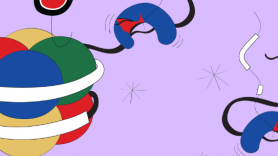2. Architecture and histones: a 3D pop-up book
More than an instruction manual, DNA works like a three-dimensional pop-up book. Constrained in the nucleus of cells, it is packaged with the help of histones, a type of protein it winds around. For some years now we have known that these histones can also undergo chemical alterations that condition DNA reading, but we are still far from understanding the code in full.
The group led by Carl Wu, professor at Johns Hopkins University in Baltimore, is unravelling some of these mysteries. For example, they have studied how the histone H2A.Z is involved in both enhancers and promoters, key areas of gene regulation. It does this through a protein called SWR1, which intercedes in its exchange for other histones that previously occupied its spot. This journey and this exchange may be key factors in controlling gene expression.
The group led by Susan Gasser, director of the Friedrich Miescher Institute for Biomedical Research in Basil, Switzerland, uses worms called C. Elegans to study how the multitude of repetitive elements in our genome that don’t give rise to proteins are controlled. Their work has established the importance of one type of methylation in type H3 histones (H3K9) for regulating and repressing transcription. Using animals in which this methylation is suppressed, they have proven that, in its absence, “there is a general deregulation and accumulation of DNA damage.”
The work of Wendy Bickmore, professor at the MRC Human Genetics Unit in Edinburgh, has proven that the spatial organization of chromosomes is also essential and that they have a preferred position inside the nucleus. Although many histone modifications depend on what are known as polycomb complexes (groups of proteins that acts as a catalyst and coordinate reactions needed to add the various chemical groups), some of their effects are not directly contingent on these modifications, but on changes caused to the spatial set-up of the DNA. This is why these complexes are called “the master weavers of the 3D genome”.
“Something I was always interested in was knowing which mechanisms allow cells to maintain their identity,” confessed Amos Tanay, of the Department of Computer Science and Applied Mathematics at the Weizmann Institute in Israel. Cells divide, but somehow the daughters remember what they were before the division. “There are several mechanisms that explain this: one of them is the marks on the DNA that are passed along when the cell divides, like methylation. But there are others, like the relationship with neighboring cells, which helps form and maintain cell identity. And, even, the organization of chromosomes inside the nucleus is important.” New ‘single-cell’ analysis techniques have allowed this group to study the architecture of the cell genome throughout its lifecycle, how it is organized into compartments and how different chromosomes come to relate to each other.



